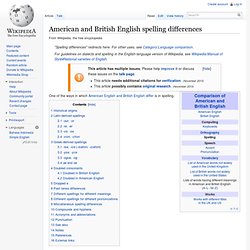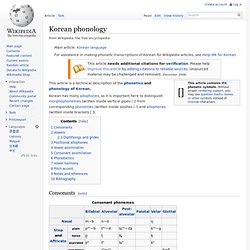

American or British. One of the ways in which American English and British English differ is in spelling.

Historical origins[edit] Extract from the Orthography section of the first edition (1828) of Webster's ADEL, the root of many American vs. British English differences: -re, -er (6); -our, -or (7); Dropped e (8); -or vs. -er (10); -ce, -se (11); doubling consonants with suffix (15) American medical text from 1814 showing the British English spellings still used at the time, such as "tumours", "colour", and "centres". In the early 18th century, English spelling was not standardised. Webster was a strong proponent of English spelling reform for reasons both philological and nationalistic.
The spelling systems of most Commonwealth countries and Ireland, for the most part, closely resemble the British system. Latin-derived spellings[edit] Popularity of some of the spelling differences mentioned on the English Wikipedia as of March 2013. -our, -or[edit] Derivatives and inflected forms Exceptions Commonwealth usage. Korean phonology. This article is a technical description of the phonetics and phonology of Korean.

Korean has many allophones, so it is important here to distinguish morphophonemes (written inside vertical pipes | |) from corresponding phonemes (written inside slashes / /) and allophones (written inside brackets [ ]). Consonants[edit] The IPA symbol 〈◌͈〉 (a subscript double straight quotation mark, shown here with a placeholder circle) is used to denote the tensed consonants /p͈/, /t͈/, /k͈/, /t͈ɕ/, /s͈/.
[note 1] Its official use in the Extensions to the IPA is for 'strong' articulation, but is used in the literature for faucalized voice. The Korean consonants also have elements of stiff voice, but it is not yet known how typical this is of faucalized consonants. /p, t, tɕ, k/ are voiced [b, d, dʑ, ɡ] between voiced sounds, but voiceless elsewhere. /m, n/ tend to be denasalized word-initially. Between vowels, /h/ may be voiced [ɦ], or may become inaudible or disappear in many cases. Revised Romanization of Korean.
The Revised Romanization limits itself to only the ISO basic Latin alphabet (apart from limited, often optional use of the hyphen).

It was developed by the National Academy of the Korean Language from 1995 and was released to the public on July 7, 2000, by South Korea's Ministry of Culture and Tourism in Proclamation No. 2000-8. The proclamation cites the following reasons for the new system:[1] It promotes consistent romanization by native Korean speakers by better transcribing important language characteristics.It reduces the confusion caused by frequent omission of apostrophes and diacritics.It rationalizes the Korean language with the plain ASCII text of internet domain names.
Features[edit] Notable features of the Revised Romanization system are as follows: In addition, it contains special provisions for regular phonological rules that makes exceptions to transliteration (see Korean phonology). Other rules and recommendations include the following: Usage[edit] Transcription rules[edit] Hangul. The Korean alphabet, also known as Hangul,[nb 1] or Chosongul (officially transcribed Han-geul in South Korea and Chosŏn'gŭl in North Korea),[nb 2] is the native alphabet of the Korean language.[1] It was created during the Joseon Dynasty in 1443, and is now the official script of both South Korea and North Korea, and co-official in the Yanbian Korean Autonomous Prefecture of China's Jilin Province.

In South Korea, Hangul is sometimes augmented by Chinese characters, called hanja, whereas in North Korea, hanja are virtually nonexistent. Hangul is a featural alphabet of 24 consonant and vowel letters. However, instead of being written sequentially like the letters of the Latin alphabet, Hangul letters are grouped into blocks, such as 한 han, each of which transcribes a syllable. That is, although the syllable 한 han may look like a single character, it is actually composed of three letters: ㅎ h, ㅏ a, and ㄴ n. Irish - Giota Beag: Irish Level 1. Modern English to Old English Vocabulary.